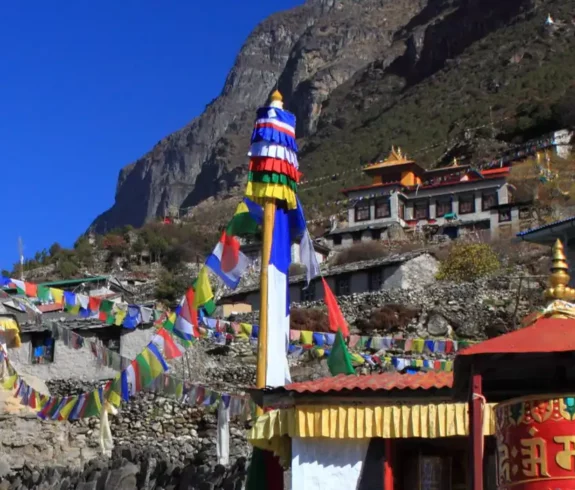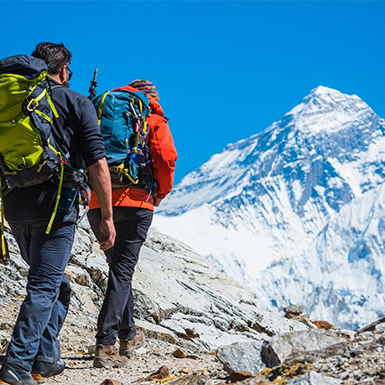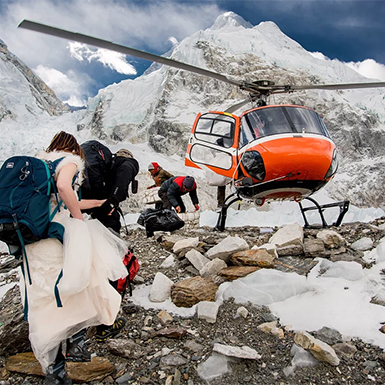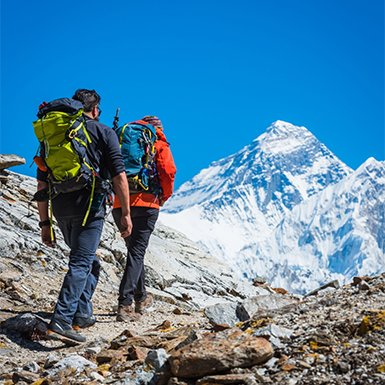Sagarmatha National Park is a celebrated natural wonder, housing the world’s highest peak, Mount Everest. This UNESCO World Heritage Site Park boasts breathtaking landscapes, diverse wildlife, and a vibrant Sherpa culture. Globally, visitors seek out this high-altitude haven to engage with its breathtaking environments and diverse wildlife.
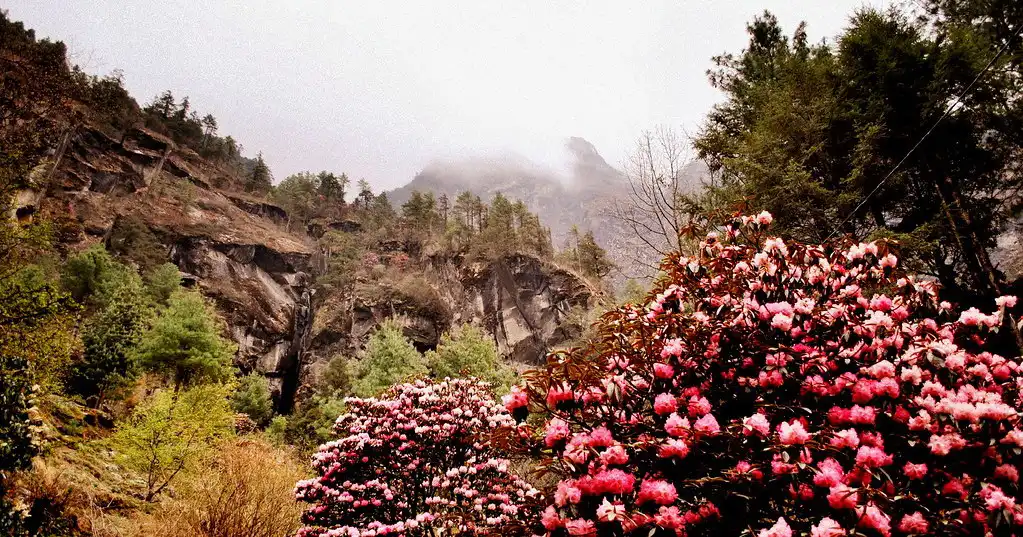
Nestled in eastern Nepal’s Solukhumbu District, Sagarmatha National Park spans 1,148 square kilometers and offers an immersive exploration into the Himalayan heartlands. This Park features everything from dense forests and swift glacial rivers to formidable cliffs with vast elevations, making it a sanctuary for adventurers and nature lovers.
Sagarmatha National Park Location: Solukhumbu District, Eastern Nepal
- Geographical Position: Located in the northeastern part of Nepal within the Solukhumbu District, Sagarmatha National Park extends from 2,845 meters up to the summit of Mount Everest at 8,848 meters.
- Entry Points: Lukla serves as the main gateway to the park, with flights readily available from Kathmandu. Trekkers commonly pass through Phakding and Namche Bazaar as they delve deeper into the park’s wonders.
- Proximity to Mount Everest: Also known as Mount Everest National Park, this area includes the southern face of the famed mountain. Trekkers on the Everest Base Camp Trek traverse this park to soak in spectacular views of Everest.
- Trekking Trails: The Park boasts various renowned trekking paths, including the Gokyo Lakes Trek and the Three Passes Trek, offering several routes for exploring its dramatic terrain.
- Accessibility: Despite its secluded location, the park is accessible via established trekking paths, helicopters, and small planes that frequently service Lukla.
Sagarmatha National Park Location
Sagarmatha National Park is in northeastern Nepal, nestled within the Solukhumbu District in the heart of the Himalayas. The Park spans 1,148 square kilometers and includes the world’s highest mountain, Mount Everest. This unique feature draws trekkers, climbers, and nature lovers from around the globe. The park’s elevation starts at 2,845 meters and rises to 8,848 meters at the peak of Mount Everest, offering visitors an incredible experience of Nepal’s diverse terrains and ecosystems.
Accessing Sagarmatha National Park through Lukla
Most visitors enter Sagarmatha National Park through Lukla, a small town that serves as the main gateway. Lukla’s Tenzing-Hillary Airport provides direct access from Kathmandu, with several daily flights making the park easily reachable. The flight takes around 30 minutes and is a popular option for trekkers starting their trek to the park.
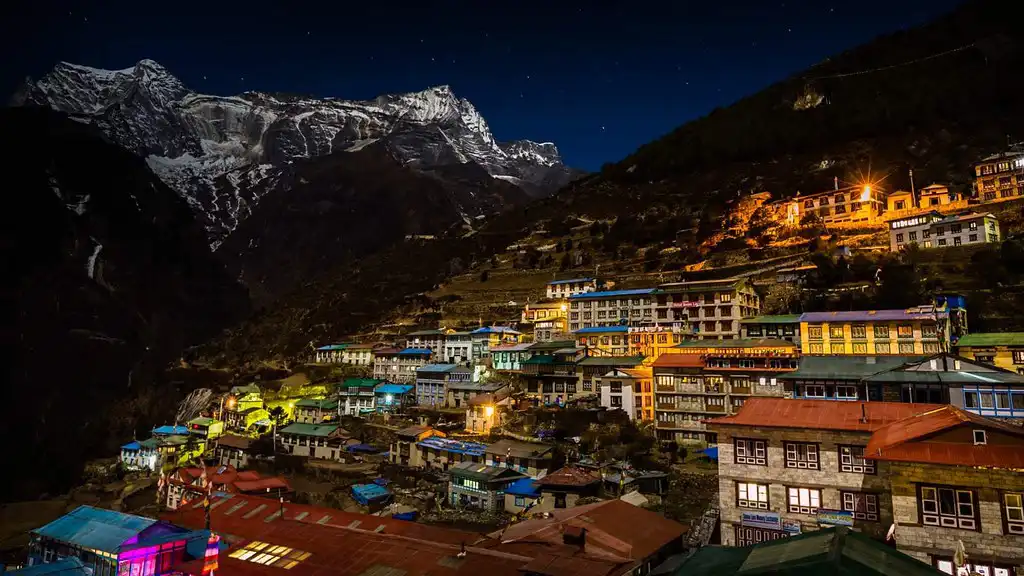
After arriving in Lukla, trekkers follow well-established paths through villages like Phakding and Namche Bazaar. These villages offer essential services such as lodges, supplies, and guides, making them ideal trekkers’ stops. From Lukla, the trek into this National Park typically takes a few days, with routes catering to beginners and experienced hikers.
Transport Information for Sagarmatha National Park
- Flights to Lukla: The fastest way to reach this National Park is by taking a 30-minute flight from Kathmandu to Lukla. However, weather conditions can sometimes affect flight schedules.
- Trekking Routes: After arriving in Lukla, trekkers continue their trek toward Namche Bazaar, a bustling village known as the gateway to the Everest region. From there, various trekking routes lead to popular destinations like Everest Base Camp and Gokyo Lakes, offering breathtaking views and opportunities to spot Sagarmatha National Park animals such as the Himalayan tahr and the snow leopard.
- Helicopter Services: If you wish to travel more quickly, helicopters are also available from Kathmandu to various locations in Everest National Park. These trips offer breathtaking aerial vistas over the park and its monumental heights.
Geography and Landscape of Sagarmatha National Park
Sagarmatha National Park, set deep within the Himalayas, showcases some of Earth’s most breathtaking and varied landscapes. Often called Mount Everest National Park, this area attracts climbers, trekkers, and nature lovers from around the world due to its stunning geographical features.
Varied Terrain of Sagarmatha National Park
- Deep Valleys: The Park features striking valleys that cut through the rugged landscape, dramatically contrasting the towering mountains. These valleys support lush vegetation and provide habitats for many wildlife species.
- Glaciers: Glaciers dominate the park’s landscape. These ancient ice formations add to the park’s beauty and sustain its ecosystems by feeding rivers and streams with fresh glacial meltwater.
- High-Altitude Mountains: The Park is famous for its towering mountains. These high-altitude peaks challenge trekkers and climbers and offer some of the world’s most thrilling and rewarding routes.
Iconic Peaks within Sagarmatha National Park
- Mount Everest: Rising to 8,848 meters, Mount Everest stands as the tallest peak on the planet. It is the most iconic landmark within this National Park and a key destination for trekkers and mountaineers.
- Lhotse: Lhotse, located near Everest, reaches 8,516 meters, making it the fourth-highest mountain globally. Climbing to its summit poses a severe challenge.
- Ama Dablam: Ama Dablam, recognized for its elegant and sharp ridges, reaches 6,812 meters. Its unique shape makes it one of the most photographed mountains in the park, beloved by climbers and photographers alike.
Altitudinal Range within the Park
- Range of Altitudes: Altitudes in this National Park start at around 2,800 meters in the village of Monjo and soar to 8,848 meters at the peak of Mount Everest. This wide range in elevation offers visitors diverse experiences, from lowland forests to high alpine conditions.
- Climatic Zones: Due to the park’s altitudinal range, visitors experience various climatic zones. Lower elevations offer temperate forests, while higher altitudes transition to barren, icy peaks with polar-like conditions.
- Trekking and Exploration: Trekkers exploring these varying altitudes can witness unique wildlife. The Park is home to Sagarmatha National Park animals, such as the Himalayan tahr and, occasionally, the elusive snow leopard. These altitudes also create different trekking difficulty levels, catering to novice and seasoned adventurers.

Sagarmatha National Park Animals and Wildlife
Sagarmatha National Park boasts remarkable biodiversity, serving as a protected haven for some of the planet’s rarest and most endangered species. Nestled in the Himalayas, the park’s varied ecosystems, shaped by its changing altitudes, support an extraordinary array of wildlife and plant life that thrive in this high-altitude environment.
Endangered Species in Sagarmatha National Park
- Snow Leopard: The snow leopard prowls the upper reaches of this National Park, making it one of the park’s most elusive and majestic predators. As a critically endangered species, the snow leopard finds refuge in this park, where it can safely hunt and breed away from human interference.
- Red Panda: The red panda inhabits the park’s lower forested regions with its distinct red fur and ringed tail. As an endangered species, it faces ongoing threats from habitat destruction and poaching, but this Park provides a vital sanctuary for its survival.
- Himalayan Tahr: Visitors often spot the Himalayan tahr, a wild goat-like animal, on the park’s steep slopes. These agile creatures easily navigate rocky terrain and serve as a key prey species for snow leopards and other predators within the park.
- Bird Species and Pheasants: This National Park is a paradise for bird enthusiasts. The Himalayan monal, Nepal’s national bird, stands out among the bird species. Other species, like the blood pheasant and the snow partridge, add vibrant colors to the park’s landscapes.
Diverse Ecosystems Shaped by Elevation
The varying altitudes within Sagarmatha National Park create distinct ecosystems, each supporting different species of flora and fauna.
- Lower Elevations (2,800 – 4,000 meters): In the lower areas, especially near Monjo and Namche Bazaar, forests of rhododendron, pine, and fir thrive. These lush forests provide essential habitats for smaller mammals like the red panda and various bird species.
- Mid-Elevations (4,000 – 5,000 meters): As you ascend higher, dense forests give way to alpine meadows and rocky terrain. You can find Himalayan tahrs, musk deer, and the occasional snow leopard in this zone. The vegetation becomes more sparse, with hardy plants such as juniper and dwarf rhododendrons enduring the colder climate.
- High Elevations (Above 5,000 meters): At these extreme altitudes, including the slopes of Mount Everest, the environment turns harsh and barren. Few species, like the Himalayan wolf and snow leopard, can survive in such conditions. The landscape is dominated by glaciers, rocks, and snow, with minimal vegetation.
Flora of Sagarmatha National Park
Sagarmatha National Park is famous for its towering peaks, including Mount Everest. It also boasts a rich tapestry of plant life that adapts to the park’s varying altitudes. The diverse vegetation zones range from lush rhododendron forests to sparse alpine meadows, each supporting its plant species.
Vegetation Zones in Sagarmatha National Park
The park’s flora varies significantly with elevation, creating distinct ecological zones rich in biodiversity.
- Rhododendron Forests: At lower elevations, the park is home to vibrant rhododendron forests. These forests bloom spectacularly during spring, painting the landscape in vivid red, pink, and white hues. Rhododendrons, Nepal’s national flower, thrive in the moist conditions at these altitudes.
- Alpine Meadows: Higher up in altitude, thick woods turn into mountain meadows. The harsh weather only affords a little protection in these areas. However, they do have a variety of tough grasses and shrubs. Wildflowers can be seen in these meadows for a short time during summer, contrasting with the white caps above them.
Wildflowers, Forests, and Shrubs
The flora in Sagarmatha National Park stands out for its resilience and adaptation to the high-altitude climate.
- Wildflowers: In the summer, the alpine meadows burst into color with wildflowers. Species like edelweiss, blue poppies, and various saxifrages have adapted to the thin air and cold temperatures. These flowers add beauty to the rugged landscape and are crucial for the local ecology, supporting insects and birds.
- Forests: The forests in this National Park are primarily composed of fir, birch, and juniper trees, as well as rhododendrons. These trees are adapted to survive the lower temperatures and moisture levels at higher elevations.
- Shrubs: Juniper is ubiquitous on shrubs and is significant in local traditions and medicine. These bushes and other lower vegetation cover the last green before rocks and ice overwhelm the top altitude.
Mount Everest National Park Significance
Also known as Mount Everest National Park, Sagarmatha National Park stands out for being the entrance to Mount Everest, which is recognized globally. As the highest mountain in the world, it has a significant role in the park. As such, climbers and trekkers flock to this place from every corner of the globe. However, besides its mountaineering significance, it also helps preserve biological diversity and the world’s cultural heritage.
Association with Mount Everest
Imagine Sagarmatha National Park with Mount Everest as its majestic centerpiece. This breathtaking mountain, reaching 8,848 meters, defines the park’s geography and global identity.
- Cultural Symbol: Mount Everest represents more than a mere mountain; it symbolizes human perseverance and adventure. Its towering presence turns the park into a sought-after destination for adventurers and explorers.
- Biodiversity Haven: The region surrounding Mount Everest supports a diverse range of high-altitude plants and wildlife. As a result, this National Park has become a vital sanctuary for preserving unique species and habitats.
Gateway to Everest Base Camp
For trekkers and climbers, Sagarmatha National Park is the starting point for the legendary trek to Everest Base Camp. This trek attracts thousands of visitors annually, eager to experience the stunning Himalayan scenery.
- Trekkers’ Destination: The Everest Base Camp trek ranks as one of the most popular routes worldwide. The Park offers well-established trails, comfortable lodges, and experienced guides for those taking on this adventure.
- Economic Contribution: The constant arrival of trekkers is crucial to enhancing the local economy. The Sherpa communities in the area primarily rely on trekking for their livelihood, which comes from employment opportunities within tourism and hospitality, such as guides or porters.
- Environmental Conservation: The global focus on Mount Everest has also brought attention to the need for conservation. Protecting the fragile Himalayan environment has become a priority, and this National Park is leading these efforts.
Trekking in Sagarmatha National Park
Sagarmatha National Park, also called Mount Everest National Park, offers some of the most famous trekking routes in the world. Adventurers and nature enthusiasts flock to these challenging trails, eager to explore the park’s stunning landscapes and rich culture. The roads lead trekkers through picturesque Himalayan villages, rugged terrain, and right into the heart of the Himalayas.
Popular Trekking Routes in Sagarmatha National Park
Each trekking route in Sagarmatha National Park presents a distinct experience, combining different difficulty levels with breathtaking scenery.
- Everest Base Camp Trek: Thousands of people dream of conquering the Everest Base Camp trek, making it one of the most sought-after hiking experiences globally. It starts from Lukla and lasts approximately two weeks, traveling through Sherpa’s remote territory. Along this route, with overnight stops at Namche Bazaar, Tengboche, or Gorak Shep, hikers can see Mount Everest and several other high-altitude mountains.
- Gokyo Lakes Trek: For those seeking fewer crowds but equally impressive scenery, the Gokyo Lakes Trek is an ideal alternative. This route leads to six spectacular glacial lakes, offering trekkers serene, panoramic views of the Himalayas.

Gokyo Ri provides a fantastic vantage point from which to see Everest and other majestic peaks. Key stops include Phakding, Namche Bazaar, and Gokyo.
- Three Passes Trek: For thrill-seekers, the Three Passes Trek challenges hikers to cross three high-altitude passes: Kongma La, Cho La, and Renjo La. This route is more demanding but offers unparalleled access to remote valleys and some of the most spectacular views in the region. Essential stops include Namche Bazaar, Lobuche, and Thame.
Important Villages Along the Trekking Routes
Trekking in Sagarmatha National Park offers more than just natural beauty; it allows trekkers to experience the culture of the Sherpa people through stops in several vital villages.
- Namche Bazaar: Known as the gateway to the high Himalayas, Namche Bazaar is a bustling village where trekkers acclimatize before ascending to higher altitudes. The village offers comfortable accommodations, restaurants, and cultural attractions like museums and monasteries.
- Pangboche: Famous for its ancient monastery, Pangboche offers spiritual and scenic allure.
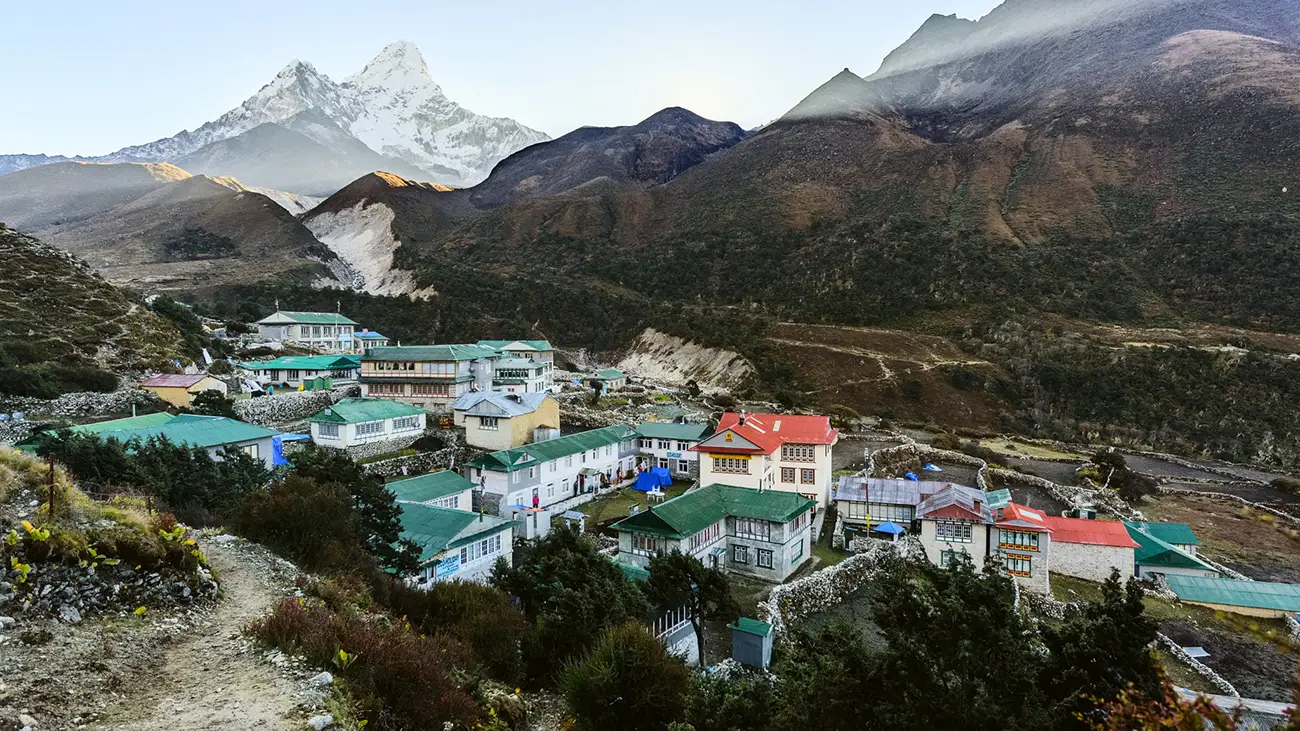
Located along the Everest Base Camp Trek, this village provides spectacular views of Ama Dablam and a peaceful resting point for trekkers.
- Dingboche: Dingboche, often a stop for acclimatization, is surrounded by towering peaks such as Lhotse, Island Peak, and Ama Dablam. The village is a crucial rest point for trekkers attempting the Three Passes Trek or heading towards Everest Base Camp.
Conservation and Environmental Challenges in Sagarmatha National Park
Sagarmatha National Park, renowned as a top trekking destination and vital ecological zone, faces significant environmental challenges. Conservation groups and park management work tirelessly to protect its delicate ecosystems from the impacts of climate change, deforestation, and the pressures of mass tourism.
Protecting Fragile Ecosystems
Ecosystems in Sagarmatha National Park are easily affected. As such, it is home to some of the most unique species of plants and animals that cannot withstand drastic changes in their habitat. There are a few essential issues that may interfere with the ecological balance of the park:
- Climate Change: Rising global temperatures have caused glaciers in Sagarmatha National Park to recede rapidly. This reduction affects freshwater supplies, alters river flow downstream, and disrupts habitats for many species. Ongoing studies aim to understand these effects better and develop solutions to protect the park’s resources.
- Deforestation: Some areas near the edges of the park face deforestation due to the demand for firewood and the need for agricultural land. Conservation efforts focus on promoting sustainable alternatives like solar energy and efficient farming practices to prevent further damage.
- Mass Tourism Impact: Thousands of trekkers visit the park annually, which puts pressure on local resources and increases waste. Managing this influx of visitors is essential to reduce the environmental strain on the park.
Regulations and Measures to Mitigate Environmental Impact
The authorities of Sagarmatha National Park take various vital actions and provide instructions to protect its natural beauty and biodiversity.
- Permit System: All trekkers must obtain permits to enter the park. This system controls the number of visitors and ensures that tourism directly supports conservation efforts.
- Waste Management: Strict rules require trekkers to manage their waste responsibly. Visitors must either carry their trash out or use designated waste disposal sites. Additionally, educational programs promote the “leave no trace” philosophy to maintain the park’s cleanliness.
- Eco-friendly Lodges: Lodges and facilities within Sagarmatha National Park are required to follow eco-friendly practices. Many use solar energy and water conservation techniques to reduce their environmental footprint. Sustainable waste management systems are also in place to handle the growing number of visitors.
- Conservation Initiatives: International collaborations help run various conservation programs focusing on habitat restoration, protecting endangered species, and building resilience against climate change in Sagarmatha National Park.
Visitor Information for Sagarmatha National Park
Exploring Sagarmatha National Park promises an exciting and unforgettable adventure. Often referred to as Mount Everest National Park, this area draws trekkers, nature enthusiasts, and adventurers worldwide. To ensure you have a safe and enjoyable experience, knowing it’s the best time to visit, understanding the permit requirements, and preparing for accommodation, food, and essential trekking gear is crucial.
Best Times to Visit Sagarmatha National Park
- Optimal Seasons: If you want to experience this National Park at its best, go there between March and May or from September to November. During these months, the weather is suitable for trekking, with stable temperatures and clear skies that are good for taking photos or going on high-altitude treks.
- Off-Peak Seasons: Visiting outside these peak seasons can mean fewer crowds but less predictable weather. From June to August, the monsoon season brings heavy rains, which may cause landslides and make trekking trails challenging.
Sagarmatha National Park Permit Requirements
- Entry Permit: All visitors must obtain a Sagarmatha National Park entry permit to access the park. You can get this permit in Kathmandu or at the Monjo Visitor Center, which lies on the route to Everest Base Camp.
- Regulations: Trekkers must follow park regulations to protect the environment, including guidelines for waste disposal and restrictions on hiking off established trails. These rules ensure that this National Park remains a pristine natural habitat for future visitors.
Tips for Accommodation, Food, and Essential Gear
Accommodation: There are diverse forms of lodging available at the park, ranging from basic teahouses to more luxurious lodges. It is advisable to book such accommodations in advance during busy trekking periods for guaranteed occupancy.
Food: Teahouses and lodges in Sagarmatha National Park serve meals ideal for trekking, focusing on providing energy-rich foods like carbohydrates and proteins. It’s also a good idea to bring some high-energy snacks, as food options become more limited at higher altitudes.
Essential Gear: Having the right gear is critical to make your trekking experience more enjoyable.
- Sturdy hiking boots: Ensure your shoes are well broken in to prevent blisters and discomfort.
- Layered clothing: Temperatures in the park vary significantly, so wearing layers will keep you comfortable day and night.
- Navigation tools: Whether it’s maps or a GPS device, having navigation tools will help you stay on track, especially in less-traveled areas.
- Sleeping bag: Even though many lodges provide bedding, having your sleeping bag ensures warmth in cold mountain conditions.
- Water purification system: Carrying a water purification system tablet or a portable filter is essential for staying hydrated while trekking.
Conclusion
Sagarmatha National Park is a remarkable blend of natural beauty and cultural heritage, offering breathtaking landscapes and rich biodiversity. Its towering peaks, most notably Mount Everest, attract adventurers worldwide. The Park protects endangered species like the snow leopard and Himalayan tahr, making it a critical conservation area. With its diverse wildlife, including many Sagarmatha National Park animals, and its stunning vistas, this park remains a top destination for nature enthusiasts and trekkers.
Sagarmatha National Park holds profound cultural importance in addition to its environmental significance. The Sherpa community enhances the experience for tourists by having spiritual ties with Mount Everest. While trekking through this beautiful landscape, one will also walk on a land with history and culture.
